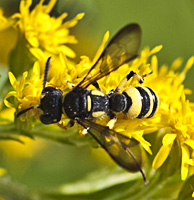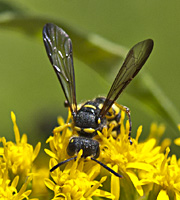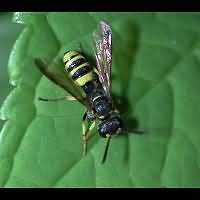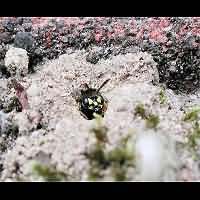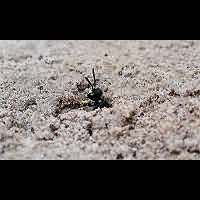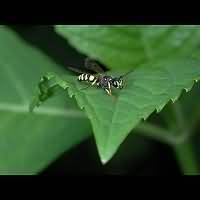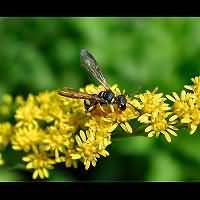[All pictures of garden wildlife on this page are thumbnails. Click on any thumbnail for a large format to be displayed.]

Cerceris quadricincta
| Taxonomy | ||||||
|---|---|---|---|---|---|---|
| Kingdom: | Phylum: | Class: | Order: | Family: | Genus: | Species: |
| Animalia | Arthropoda | Insecta | Hymenoptera | Crabronidae | Cerceris | C.quadricincta |
The Digger Wasps in the genus Cerceris are very similar to paper wasps and Sawflies. They are easy to approach and take pictures of as they usually just sit a cluster flowers without moving too much. If they notice your presence they feel threatened and then they slightly spread their wings. A that moment they mimic the looks of a small and slender yellowjacket, as this position clearly reveals the warning colours. However the German expert Heiko Bellmann writes that by spreading its wings is yet another defence tactics, namely it simply prepares for a swift take off. Most Cerceris species hunt for weevils which they to feed to their larvae. Thus they are often refered to as Weevil Hunting Wasps. Some Cerceris hunt for other prey though which is usually bees. Of most species the females may be identified in the field, even though a few may confront you with some challenges. Males of most species are too similar to be identified in the field. The bottom picture shows a male.
Cerceris quadricincta is a wasp with black and yellow colouring. Especially the first yellow line on the abdomen often is quite broad. Females have a very pointed and slender bottom and are entirely yellow on the underside. The males are very similar to those of other Cerceris species, especially of Cerceris arenaria. Usually they can not be identified in the field. Males reach a length of 6 to 10mm, females are 7 to 11mm long.
The nests are constructed in firm sandy soil. They are hard to find for they are camouflaged by vegetation. Each egg is provided with 5 to 15 weevils, usually the bigger Polydrosus species or the very small Apion species. Adults often visit flowers, including those in gardens. Extremely rare in Britain and only found in two counties in England. Quite common on the continent except for in Scandinavia. Also present in much of Western Asia and Northern Africa. It is on the wing from May to the end of October.

© Copyright 1998-2024 gardensafari.net (Hania Berdys)

 English / engels
English / engels  Dutch / nederlands
Dutch / nederlands